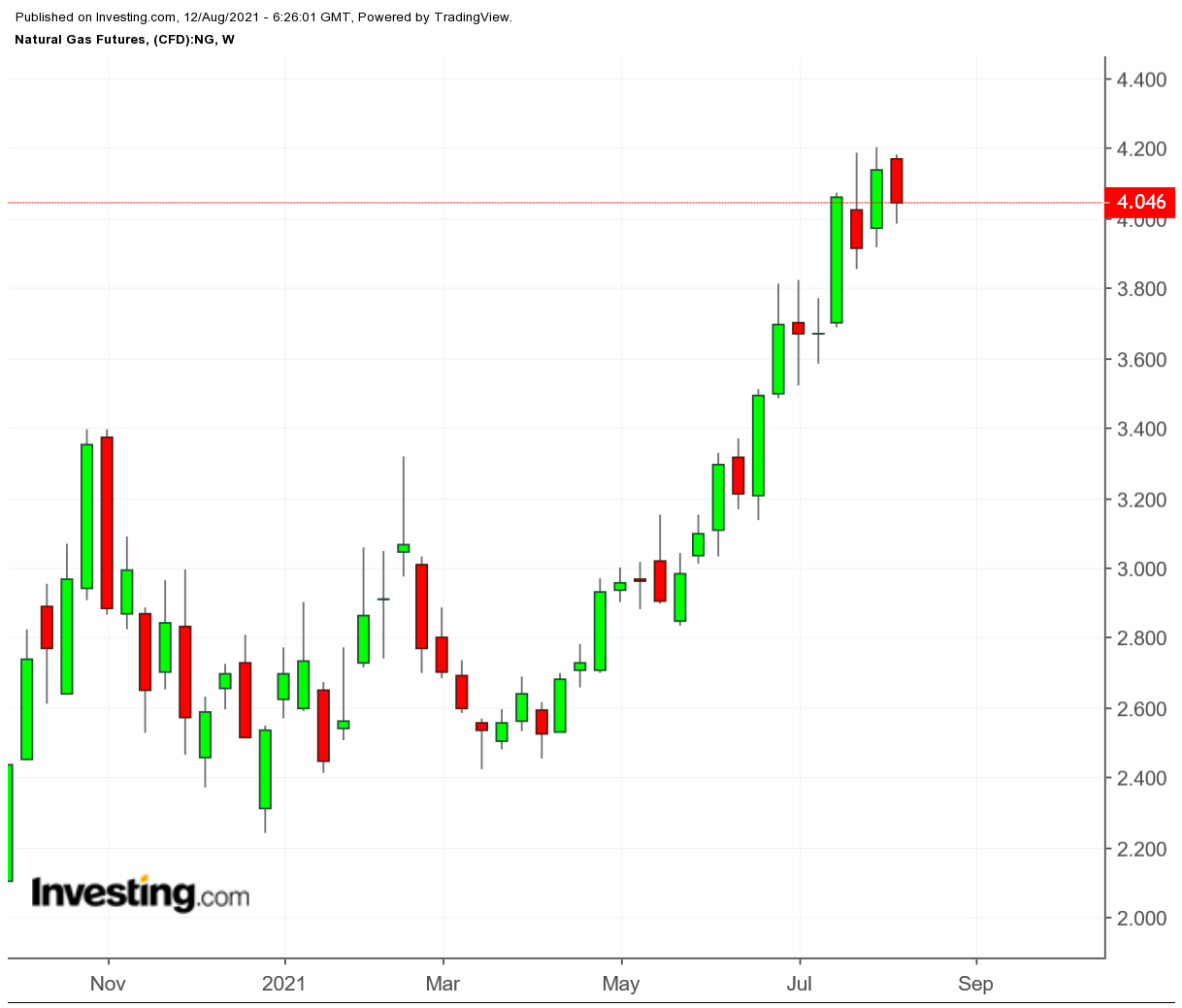United Homes Group stock plunges after Nikki Haley, directors resign
Natural gas prices have declined four times in five sessions while hitting near three-year highs in the same stretch. To bears, it’s a sign the extraordinary bull party that has prevailed since the start of the year may be coming to an end. To longs, last Thursday’s peak above $4.20 is a sign the good run isn’t over yet.
The truth may be somewhere in between.

As market participants brace for another weekly update today from the US Energy Information Administration on the storage situation in gas, analysts tracked by Investing.com predict on average that 49 billion cubic feet were added to inventories last week, from what was left over from new production not burned for power generation and cooling.
That would be well above the 13 bcf injected into storage during the previous week ending July 30. It would also be higher than the five-year average (2016-2020) injection of 44 bcf.
To short-sellers, the inventory forecast is a sign to start pressing for lower gas prices.
At Wednesday’s session on the New York Mercantile Exchange, front-month gas on the Henry Hub settled down 3 cents, or 0.7%, at $4.06 per mmBtu, or million metric British thermal units. That was 15 cents, or almost 4%, below the $4.21 per mmBtu peak seen on Aug. 4 and 5—the highest since the $4.66 levels seen in December 2018.
If gas maintains its present trajectory, it could end the week about 2% or more lower, after last week’s 5.8% gain. That’s really nothing for a market that can swing 20% or more in a more adventurous week.
Yet, if one is looking for a particular starting point to attach market sentiment to weather shifts, then this could be a significant one, says Dan Myers, analyst at Houston-based gas markets consultancy Gelber & Associates.
Temperature Anomalies
In a note circulated to clients of the firm and shared with Investing.com on Wednesday, Myers said:
“Temperature anomalies that leaned towards the cool side of the spectrum have limited weather-driven demand during the week of storage.”
“As summer temperatures begin to decline, lower weather-driven demand will allow storage injections to grow larger through the remainder of the month of August.”
Bespoke Weather Services concurred with that in a forecast carried by industry portal natgasintel.com.
Myer continued: “It is next week’s number that will show the loosening, with risk being higher than our current 22 Bcf. Expect choppy price action to continue in the near term.”
Even so, Myers cautions short-sellers to beware of another potential hurrah for bulls next week if a late summer heat anomaly occurs as predicted by weather forecasters. This could again send demand for cooling—and gas prices—spiking, he says.
“The real buzz is around next week’s injection, which is expected to come in at 9 bcf,” he added. “This low injection will be primarily driven by peaking summer temperatures.”
Risky Short Supply For Cold Season?
And while analysts could be right with last week’s forecast build of 49 bcf, that injection would only take gas in inventory to 2.776 tcf, or trillion cubic feet. That would still be 6% below the five-year average and 16.5% below the same week a year ago.
That could be dangerously short supply for heating needs, if the coming cold season, beginning October, turns out to be more chilly than thought.
Last week, temperatures were milder-than-usual with just 80 cooling degree days versus a 30-year average of 88 CDDs, according to data provider Refinitiv. CDDs, used to estimate demand to cool homes and businesses, measure the number of degrees a day's average temperature is above 65 degrees Fahrenheit (18 degrees Celsius).
For this week, early estimates from analysts tracked by Refinitiv are that there will be an addition of anywhere from 9 to 45 bcf, with a mean of 26 bcf. That will compare with an injection of 45 bcf during the same week last year and a five-year average build of 42 bcf.
As for latest weather outlooks, natgasintel.com reported that models have not deviated much in showing cooler temperatures arriving this weekend and lingering through the early part of next week.
Storm Fred Looming
Part of the expected cooldown, according to natgasintel.com, is to come from Tropical Storm Fred, which on the forecast track was expected to be near or over Hispaniola late Wednesday, based on readings cited from the National Hurricane Center.
Fred would likely move near the Turks and Caicos Islands and the southeastern Bahamas on Thursday and near or north of the northern coast of central Cuba on Friday, the NHC said. A U.S. landfall is expected near South Florida over the weekend, likely as a tropical storm. From there, it could move along the Gulf Coast into the Southeast Monday and Tuesday.
Added NatGasWeather:
“Fred is still expected to remain below hurricane strength but could delay LNG cargoes and weaken production slightly in the Gulf of Mexico.”
The lower demand that could result from Fred’s arrival would provide at least some relief to a gas market that’s become increasingly jittery over supply levels ahead of winter. US storage inventories are struggling to refill this injection season, as robust power burns and strong export demand have left little gas left to replenish stocks.
Disclaimer: Barani Krishnan uses a range of views outside his own to bring diversity to his analysis of any market. For neutrality, he sometimes presents contrarian views and market variables. He does not hold a position in the commodities and securities he writes about.
